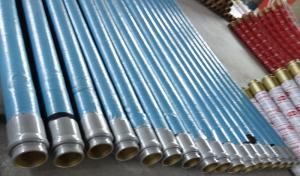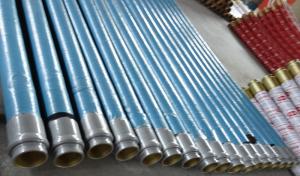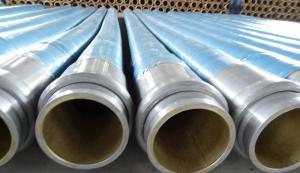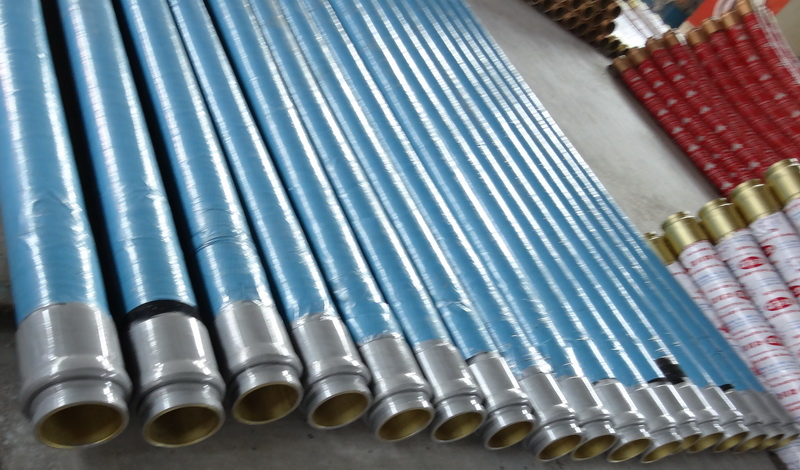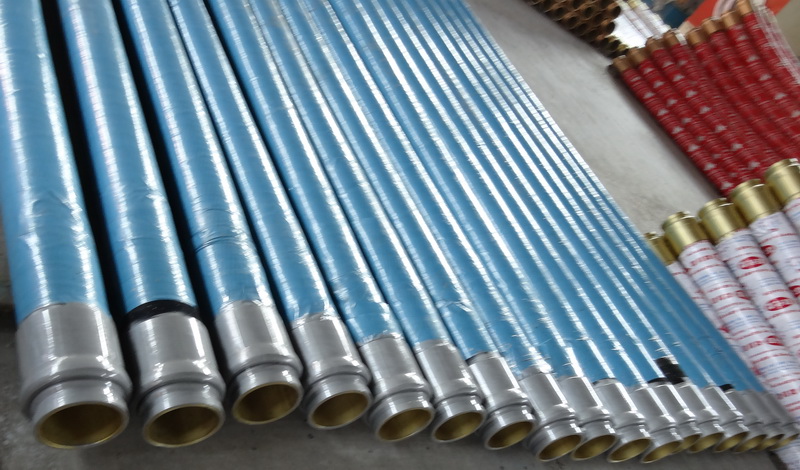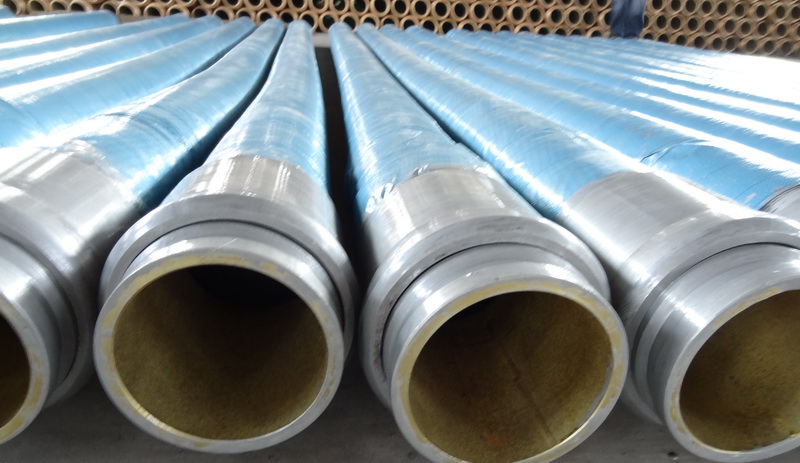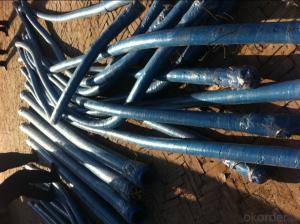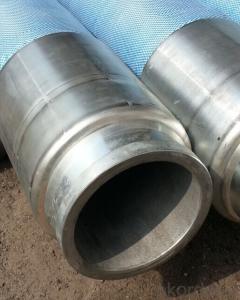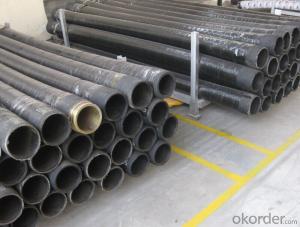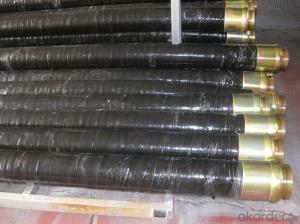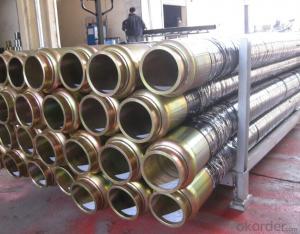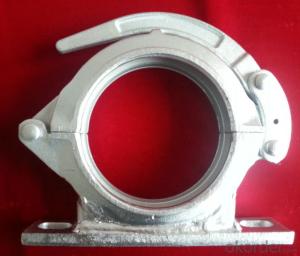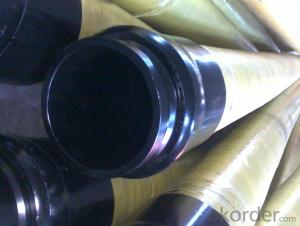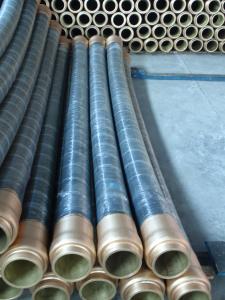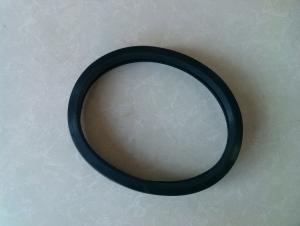RUBBER END HOSES 3 METERS
- Loading Port:
- Shanghai
- Payment Terms:
- TT or LC
- Min Order Qty:
- -
- Supply Capability:
- -
OKorder Service Pledge
OKorder Financial Service
You Might Also Like
Product Description:
Product Name: Rubber End Hose 5’’ 3M
1. Specification
Type: 2 layers steel wire or 4 layers steel wire
working pressure: 85bar or 1232PSI
Dimensions: DN100MM, DN125MM, DN150MM, 4'', 5", 6''
Flanges: Single end, or double ends
Coupling: Painted or Galvanized.
Different Length : 3m, 4m, 5m.
Notes: total series of rubber hose for different brand concrete pump available from us, different length of rubber hose as customers requirments .
2. Application
Widely used on concrete pump truck, concrete placing boom, trailer concrete pump etc, for concrete delivery and placement pumping.
Our rubber hoses for concrete pump have been successfully exported to many countries from 1998, Our main markets as below: Middle East, Southeast Asia, America, Brazil, Italy, Russia, South Africa etc.
Aiming at the largest concrete pump parts manufacturer, and reliable, professional supplier in China, we can supply concrete pump elbows, delivery pipes, casting or forging couplings, end rubber hoses, rubber pistons, tungsten wear plates, delivery cylinders, and other hydraulic parts, one stop service for your concrete pump parts and accessory business.
3. Package and Delivery
Every 200pcs put in one 20 feet container.
4. Production
Our Concrete Pump rubber hoses are made with advanced technology of weaving and natural rubber formula.
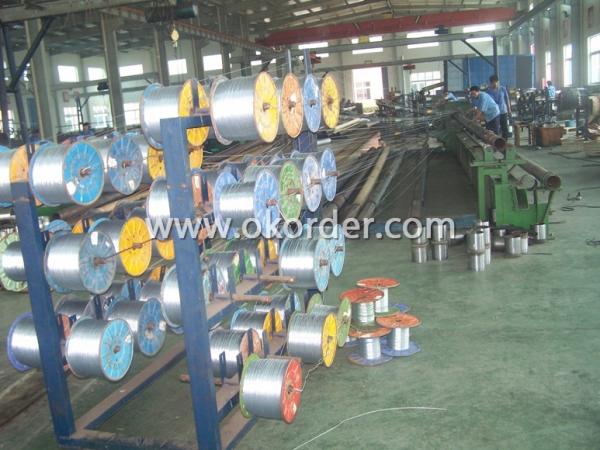
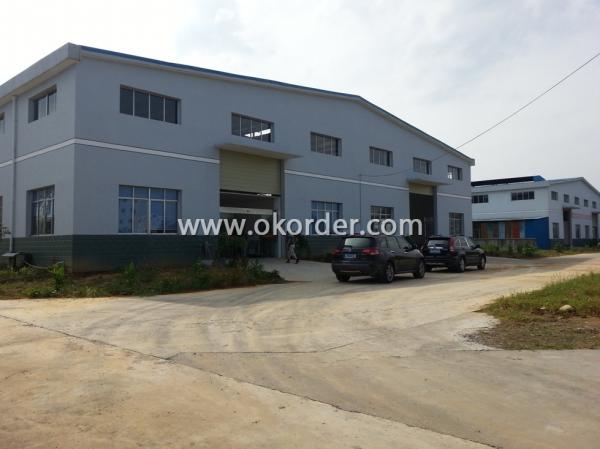
5. Why choose us?
1) Brand-name Parts
2) Country of Origin
3) Competitive Price
4) Good Product Performance
5) Prompt Delivery
6) Quality Approvals
7) Good Reputation
8) Expedite Communication
9) Good Packaging
10) Distributorships Offered
11) One Step Service
12) Good Quality Service
13) Small Orders Accepted
14) Overseas Service Branches
- Q: What are the different types of concrete pump wear rings?
- There are several different types of concrete pump wear rings that are commonly used in the construction industry. The most common types include: 1. Metallic Wear Rings: These wear rings are typically made of hardened steel or stainless steel. They are highly durable and can withstand the abrasive nature of concrete. Metallic wear rings are designed to be long-lasting and provide excellent wear resistance. 2. Polyurethane Wear Rings: Polyurethane wear rings are made from a high-performance polymer material. They are known for their exceptional resistance to abrasion, impact, and chemical exposure. Polyurethane wear rings are often preferred for their flexibility and ability to provide a tight seal, reducing leakage and improving pump performance. 3. Ceramic Wear Rings: Ceramic wear rings are made from a high-density ceramic material, such as alumina or zirconia. They are extremely hard and have excellent resistance to wear and corrosion. Ceramic wear rings are commonly used in high-pressure applications where there is a need for superior durability and performance. 4. Composite Wear Rings: Composite wear rings are made by combining different materials, such as metal and polymer, to create a hybrid material. These wear rings offer the advantages of both materials, such as the strength of metal and the flexibility of polymers. Composite wear rings are often used in applications where a balance between durability and flexibility is required. Each type of wear ring has its own unique advantages and considerations. The choice of wear ring depends on various factors, such as the specific application, operating conditions, and budget constraints. It is important to consult with experts or manufacturers to determine the most suitable wear ring for a concrete pump.
- Q: Can concrete pump spare parts be resold or traded in for new parts?
- Yes, concrete pump spare parts can be resold or traded in for new parts. Depending on the condition and demand for the specific parts, reselling them can be a viable option to recover some of the initial investment. There are various platforms, both online and offline, where individuals or businesses can sell their used concrete pump spare parts. Additionally, some manufacturers or distributors may offer trade-in programs where old parts can be exchanged for new ones, providing customers with a cost-effective way to upgrade their equipment. However, the resale value or trade-in options may vary depending on factors such as the age, condition, and market demand for the specific spare parts.
- Q: What are the indications of a faulty control lever?
- There are multiple indications that may suggest a malfunctioning control lever. Firstly, if the control lever does not respond or is sluggish when attempting to engage or disengage a specific function, it could be indicative of an issue. This may include difficulties in shifting gears, adjusting speed, or operating various controls such as the throttle or clutch. Another sign of a faulty control lever is if it becomes loose or unstable. If you observe excessive play or movement in the lever, it could imply that the mechanism connecting the lever to the control system is worn out or damaged. This can compromise the accuracy and precision of the control lever, making it challenging to effectively operate the intended functions. Furthermore, any unusual noises or vibrations originating from the control lever can serve as an indication of a fault. This might be a consequence of loose or broken components within the control lever assembly, suggesting the need for inspection and repair. Lastly, if the control lever becomes stuck or jammed in a particular position, it clearly signifies a faulty lever. This can hinder proper control of the equipment or vehicle, posing safety risks. In any case, if there is suspicion of a faulty control lever, it is crucial to have it inspected and repaired by a qualified technician to ensure proper functioning and safe operation.
- Q: How often should concrete pump hydraulic oil coolers be inspected and maintained?
- To guarantee optimal performance and avoid possible problems, it is necessary to carry out regular inspections and maintenance on the hydraulic oil coolers of concrete pumps. The frequency of these procedures will vary depending on factors such as the pump's operating conditions, workload, and the recommendations provided by the manufacturer. As a general rule, it is advisable to inspect and maintain the concrete pump hydraulic oil coolers at least once every six months or every 500-700 operating hours, whichever comes first. However, in more demanding or extreme operating conditions, it may be necessary to perform these tasks more frequently. During these inspections, it is of utmost importance to thoroughly clean the cooler and examine it for any signs of damage, corrosion, or leaks. It is also crucial to inspect the cooler's fins for any blockages, as the presence of debris or dirt can decrease its efficiency. Regularly checking and replacing the air filters of the cooler is equally important to ensure proper airflow and prevent overheating. In terms of regular maintenance, it is vital to replace the hydraulic oil and filters according to the manufacturer's recommendations. This action helps maintain the oil's viscosity and prevents any contaminants from causing damage to the cooler or other hydraulic components. To summarize, conducting regular inspections and maintenance on concrete pump hydraulic oil coolers is crucial to ensure efficient operation and prolong their lifespan. By adhering to the manufacturer's guidelines and taking into account specific operating conditions, it is possible to determine the appropriate frequency for these inspections and maintenance tasks.
- Q: How do I properly maintain and replace hydraulic valves in concrete pump spare parts?
- Proper maintenance and replacement of hydraulic valves in concrete pump spare parts involve a few key steps. Firstly, it is crucial to regularly inspect the valves for any signs of wear, damage, or leakage. This can be done by checking the valve body, seals, and connections. Secondly, ensure that the valves are lubricated according to the manufacturer's recommendations to prevent friction and extend their lifespan. Additionally, it is essential to adhere to the specified pressure and temperature limits during operation, as exceeding these limits can lead to valve failure. When it comes to replacement, it is recommended to consult the equipment manual or seek professional assistance to ensure that the correct valves are selected and installed accurately. Regular maintenance and timely replacement of hydraulic valves will ensure the optimal performance and longevity of the concrete pump spare parts.
- Q: How often should concrete pump booms be inspected and maintained?
- To ensure the safe and efficient operation of concrete pump booms, it is important to inspect and maintain them regularly. The frequency of these inspections and maintenance tasks will depend on how often and under what conditions the boom is used. Generally, it is recommended to inspect and maintain the boom at least once a month or after every 250 pumping hours, whichever comes first. During these inspections, it is crucial to carefully examine the boom for any signs of wear and tear, damage, or malfunctioning parts. The hydraulic system, including the hoses, cylinders, and valves, should be thoroughly inspected and tested for leaks, blockages, or malfunctions. Additionally, the structural integrity of the boom, such as the main boom, articulation points, and outriggers, should be checked for cracks, deformations, or signs of stress. Regular maintenance of the concrete pump boom should include cleaning and lubricating all movable parts, checking and adjusting the tension of the cables, belts, and chains, and replacing any worn-out or damaged components. It is also important to inspect and test the electrical and control systems to ensure proper functioning. In addition to regular inspections and maintenance, it is crucial to follow the manufacturer's guidelines and recommendations for specific maintenance intervals and procedures. Depending on the level of usage, working conditions, and any changes in performance or operation, it may be necessary to conduct more frequent inspections and maintenance. By conducting regular inspections and maintenance, concrete pump boom owners can reduce the risk of accidents, extend the lifespan of the equipment, and ensure optimal performance. It is always advisable to consult with the manufacturer or a qualified professional to determine the most suitable inspection and maintenance schedule for a specific concrete pump boom.
- Q: How do I properly adjust and control flow rates in concrete pump spare parts?
- To properly adjust and control flow rates in concrete pump spare parts, there are a few key steps to follow: 1. Understand the equipment: Familiarize yourself with the specific concrete pump spare parts you are working with. Read the user manual and refer to any documentation provided by the manufacturer. This will help you gain a comprehensive understanding of the equipment's capabilities and how to adjust flow rates effectively. 2. Check the pump settings: Before starting any concrete pumping operation, ensure that the pump settings are properly configured. This includes checking the hydraulic pressure, engine RPM, and any other relevant settings. Make sure all valves and controls are in the correct position for the desired flow rate. 3. Monitor the pump speed: The speed of the pump directly affects the flow rate of the concrete. Different concrete mixtures may require different pump speeds to achieve the desired flow rate. Adjust the engine RPM accordingly, referring to the manufacturer's recommendations and any specific requirements for the project. 4. Adjust the pump stroke: Most concrete pumps have adjustable pump strokes to control the flow rate. By changing the length of the stroke, you can increase or decrease the volume of concrete being pumped. Experiment with different stroke lengths to find the optimal flow rate for your specific application. 5. Use the control panel: Many concrete pumps come equipped with a control panel that allows for precise adjustment of flow rates. Take advantage of these features to fine-tune the flow rate. Use the control panel to monitor the pump's performance and make any necessary adjustments to maintain a consistent flow. 6. Regularly inspect and maintain the equipment: Proper maintenance is crucial to ensure the accurate adjustment and control of flow rates. Regularly inspect the concrete pump spare parts for any signs of wear or damage. Clean and lubricate the components as recommended by the manufacturer. A well-maintained pump will operate more efficiently and provide more accurate control over flow rates. By following these steps, you can properly adjust and control flow rates in concrete pump spare parts. Remember to always prioritize safety and consult the manufacturer's instructions and guidelines for specific recommendations and considerations.
- Q: What is the purpose of a concrete pump cylinder?
- The primary aim of a concrete pump cylinder is to generate the required pressure and force for the transportation and delivery of concrete to a desired location. It serves as a vital element within a concrete pump, facilitating the smooth and productive movement of concrete throughout the pump system. The cylinder operates by utilizing hydraulic pressure to propel the concrete through the pipeline, guaranteeing a continuous and seamless flow. Its significance lies in its contribution to construction projects, enabling accurate and efficient placement of concrete in diverse settings such as buildings, bridges, and other structures. By supplying the necessary power and pressure, the concrete pump cylinder ensures effortless and labor-saving transportation of concrete over long distances, both vertically and horizontally. Ultimately, its purpose revolves around enhancing the efficiency and precision of concrete delivery, thereby saving time and effort in construction endeavors.
- Q: How can a faulty electric motor affect the pump's performance?
- The performance of the pump can be significantly affected by a defective electric motor. To begin with, the motor is responsible for supplying the necessary power to operate the pump. If the motor is faulty, it may fail to generate the required amount of power, leading to a decline in the pump's performance and efficiency. This can result in decreased flow rates and lower pressure output, which in turn hampers the pump's functioning. Furthermore, a defective motor can also give rise to problems such as increased energy consumption and overheating. In case the motor is not working properly, it may consume excessive electrical current, resulting in higher energy usage and elevated operational costs. Moreover, an overheating motor can cause damage to the pump and other associated components, thereby further affecting performance and potentially leading to expensive repairs or replacements. Moreover, the reliability and lifespan of the pump can also be compromised by a defective motor. Operating the pump continuously with a faulty motor can subject it to excessive strain, resulting in premature wear and tear, heightened maintenance requirements, and a shorter lifespan. Consequently, frequent breakdowns, downtime, and a decline in overall productivity may occur. In conclusion, a defective electric motor can have various adverse effects on the pump's performance, including reduced flow rates, diminished pressure output, increased energy consumption, overheating, and decreased reliability. Therefore, it is crucial to regularly inspect and maintain motors to ensure their optimal functioning and prevent any detrimental impact on the pump's performance.
- Q: Are there any specific safety precautions for handling concrete pump spare parts?
- Concrete pump spare parts require specific safety precautions to be followed. It is essential to wear the appropriate personal protective equipment (PPE) like gloves, safety goggles, and a dust mask. This ensures protection against potential hazards, as concrete dust can harm the skin and cause respiratory issues if inhaled. Proper lifting techniques are crucial when handling these spare parts to prevent strains or injuries. Heavy parts should be lifted using lifting equipment or with the assistance of others to minimize accidents. Moreover, it is vital to handle the spare parts with care and avoid rough handling or dropping to prevent damage or breakage. Damaged spare parts can negatively impact the concrete pump's performance and safety. Storing the spare parts in a clean, dry area away from moisture or chemicals is also important. This prevents potential damage that may compromise the quality and integrity of the spare parts. Lastly, it is advisable to always follow the manufacturer's instructions and guidelines for handling concrete pump spare parts. They provide specific safety precautions and recommendations, ensuring the parts are handled and used safely. By adhering to these safety precautions, the risk of accidents, injuries, and damage to the concrete pump spare parts can be minimized, creating a safe working environment.
Send your message to us
RUBBER END HOSES 3 METERS
- Loading Port:
- Shanghai
- Payment Terms:
- TT or LC
- Min Order Qty:
- -
- Supply Capability:
- -
OKorder Service Pledge
OKorder Financial Service
Similar products
Hot products
Hot Searches
Related keywords
